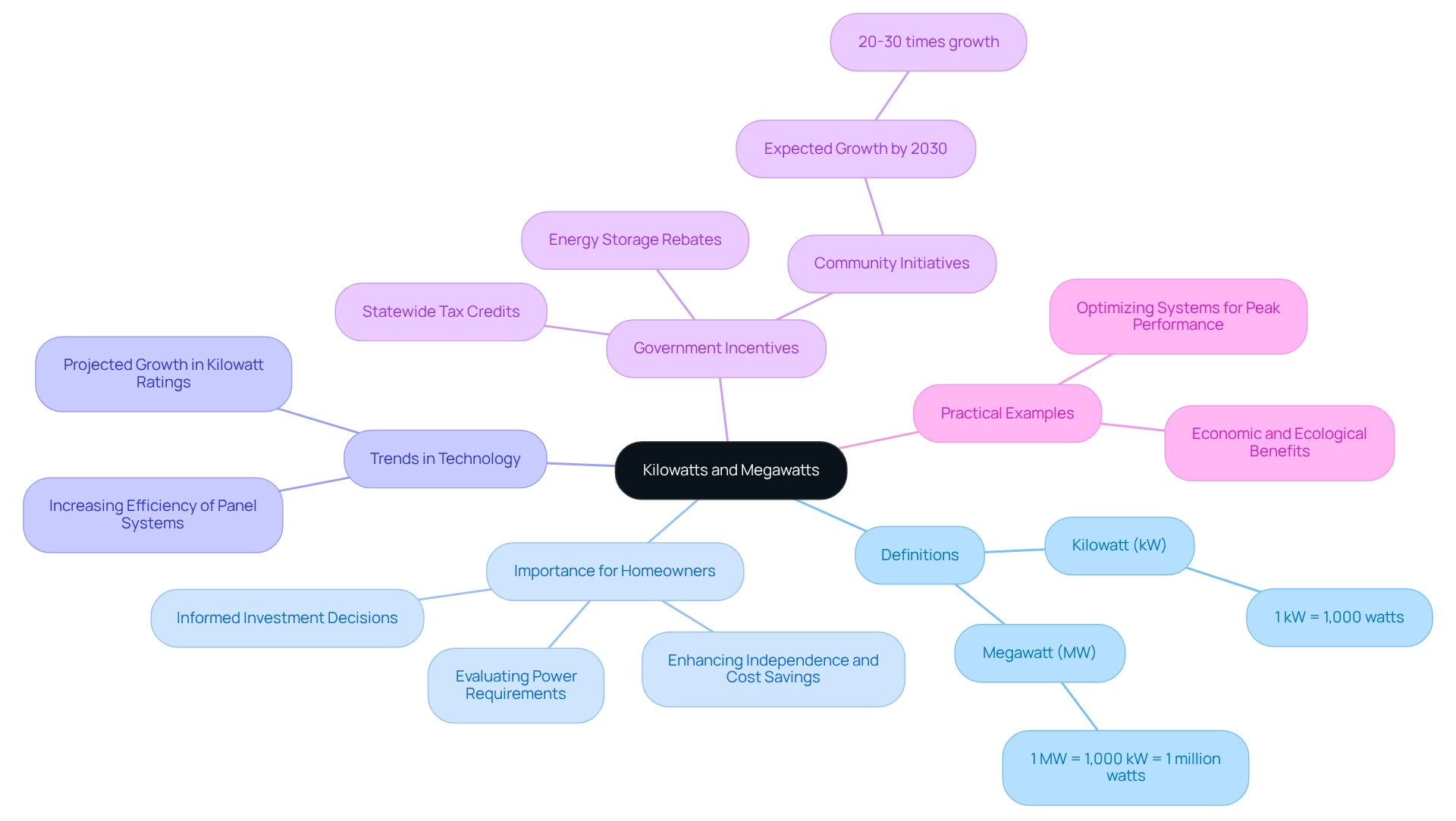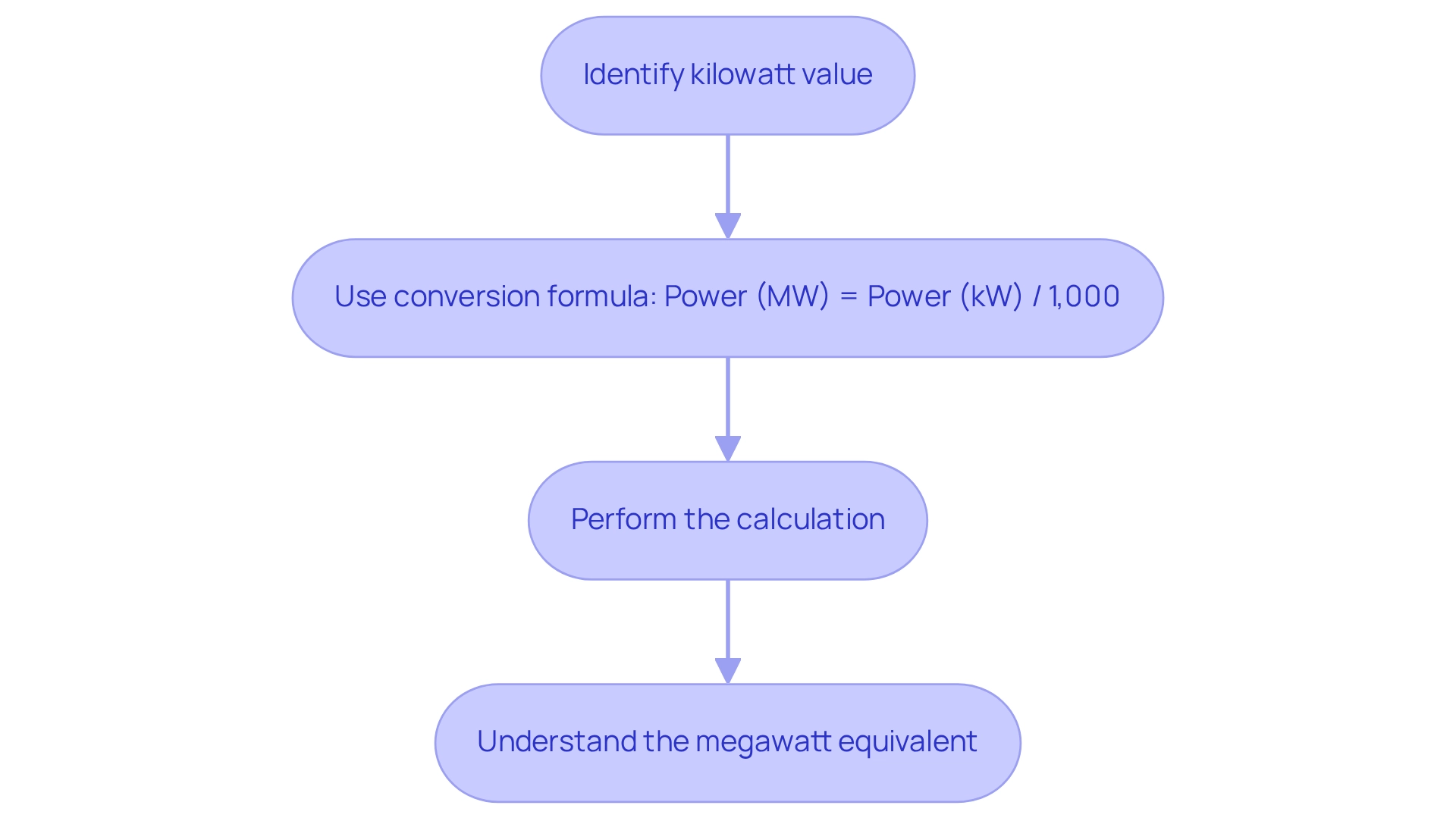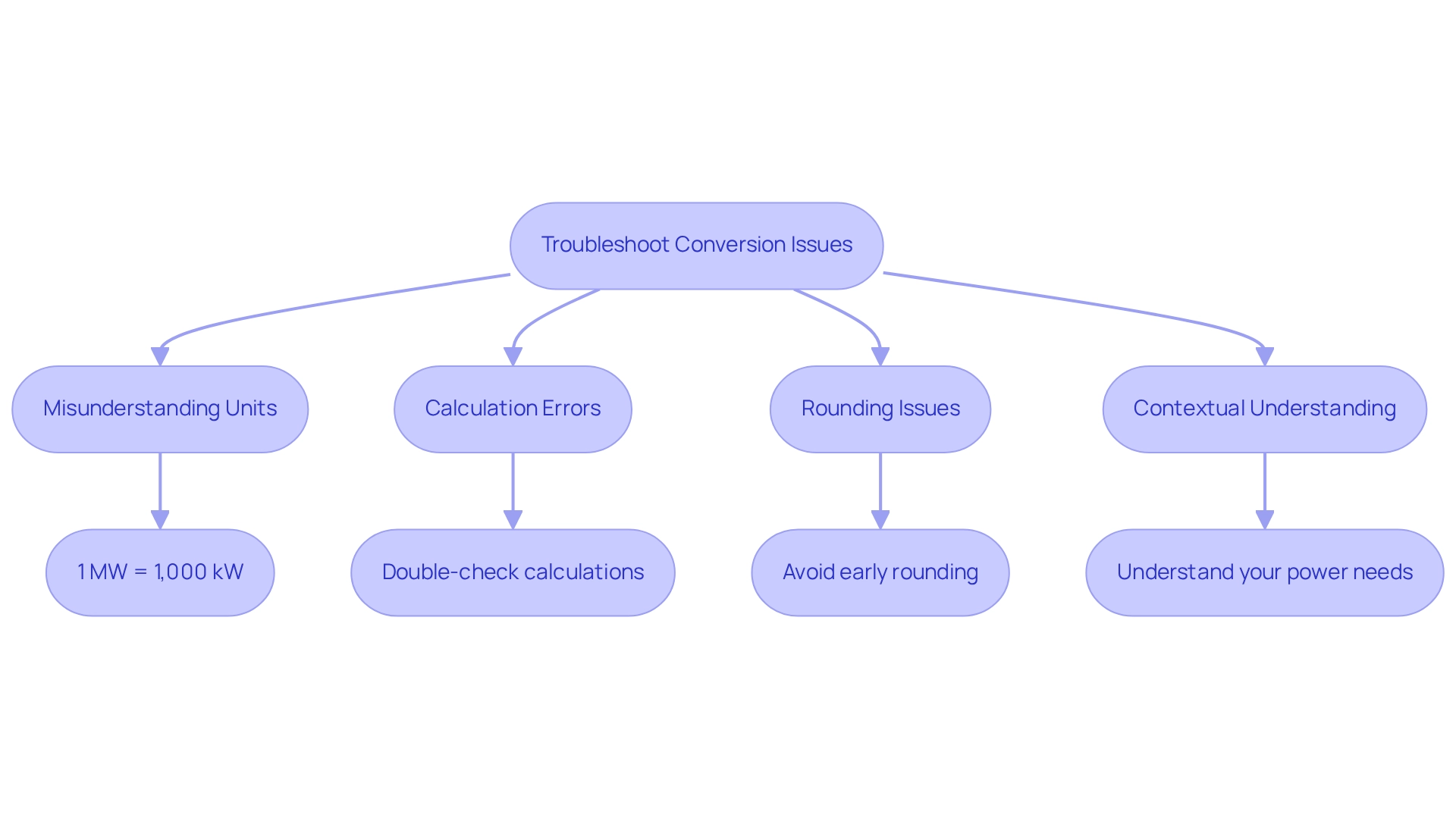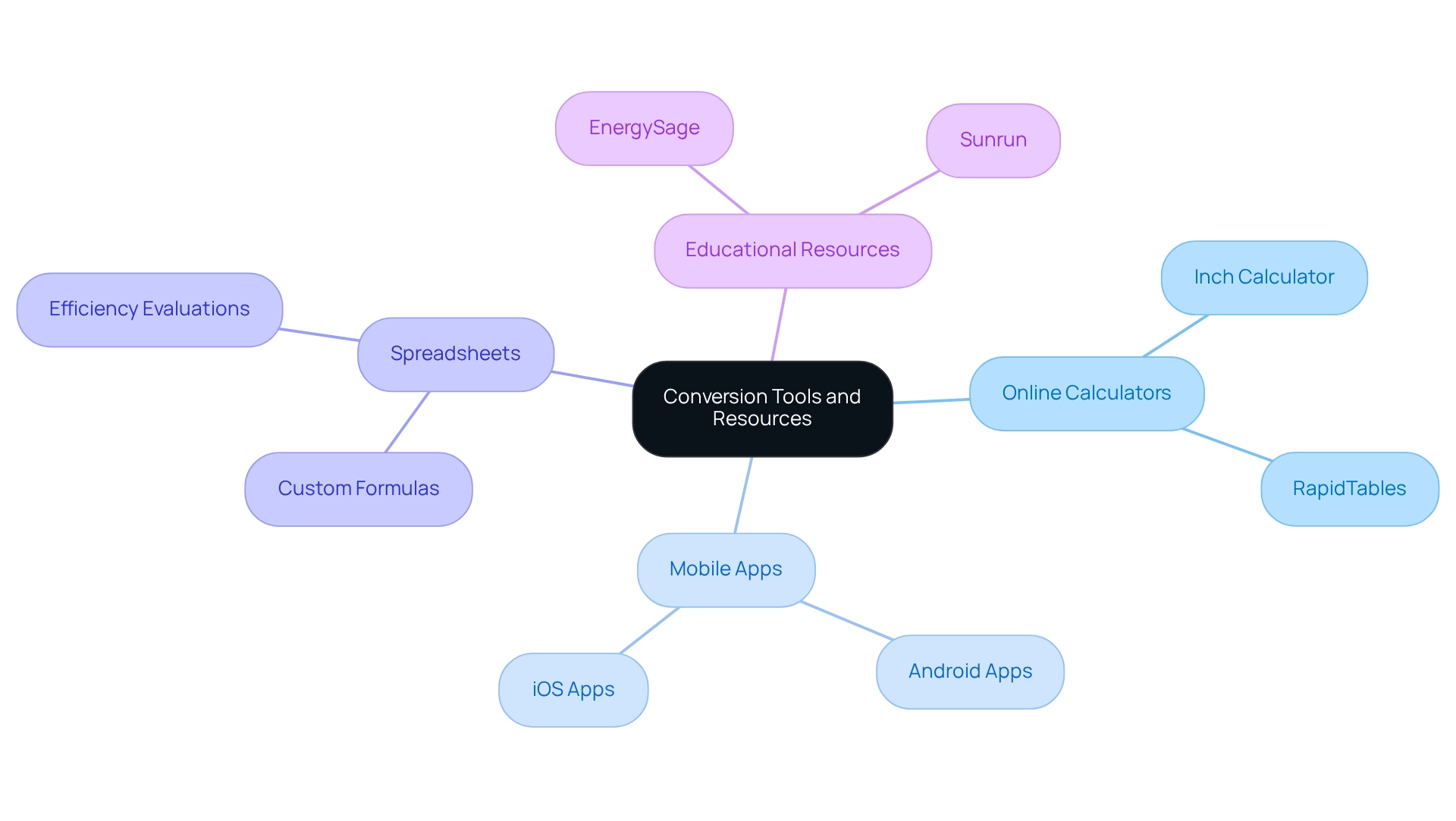Overview
Are you feeling overwhelmed by your energy bills? Understanding how to convert kilowatts (kW) to megawatts (MW) can be a crucial step towards managing your energy consumption more effectively. To make this conversion, simply divide the kilowatt value by 1,000, as 1 MW equals 1,000 kW. This knowledge is not just a number; it’s a pathway to evaluating energy efficiency and optimizing your renewable energy investments. By doing so, you can unlock significant cost savings and take control of your energy usage.
Together, we can explore how understanding this conversion can empower you. Imagine the peace of mind that comes with knowing you’re making informed decisions about your energy consumption. If you’re ready to take the next step towards energy independence, we’re here to support you every step of the way. Let’s work together to create a sustainable future that benefits both your home and the environment.
Introduction
In the quest for energy independence, we understand that many homeowners are concerned about rising energy bills and the impact on their budgets. Understanding the nuances of power measurement is essential, especially for those considering solar energy solutions.
Kilowatts (kW) and megawatts (MW) may sound like technical jargon, but they are critical units that inform your decisions about energy consumption and system performance. As the solar landscape evolves, grasping these measurements becomes increasingly important. This knowledge empowers you to optimize your investments and enhance energy efficiency.
With the rise of community solar initiatives and government incentives, the opportunity to harness solar power has never been more accessible. Together, we can explore the significance of kW and MW, conversion techniques, common pitfalls, and the tools available to streamline the process.
This journey will empower you to make informed choices as you transition to sustainable energy practices, ensuring a brighter future for your home and community.
Understand Kilowatts and Megawatts
Kilowatts (kW) to megawatt (MW) conversions are essential units of power measurement that play a significant role in assessing output and usage. A kilowatt represents 1,000 watts, while converting kW to megawatt shows that a megawatt equals 1,000 kilowatts or 1 million watts. We understand that for property owners, especially those considering renewable power alternatives, grasping these units is crucial for evaluating power requirements and the functionalities of these systems.
For instance, a typical residential photovoltaic installation in California is generally rated at approximately 5 kW, signifying it can produce 5,000 watts of energy under ideal conditions. This understanding empowers property owners to make informed choices about their power usage and renewable investments.
As you may have noticed, recent trends suggest that as photovoltaic technology progresses, the average kilowatt ratings of residential energy systems are anticipated to rise, showcasing the increasing efficiency of panel systems. Moreover, experts emphasize that understanding kW and MW is essential for homeowners to enhance their independence and achieve cost savings.
Looking ahead to 2025, the significance of these measurements is underscored by the growing adoption of renewable power solutions, with community initiatives expected to flourish. This growth is supported by several incentive programs, such as statewide tax credits and storage rebates, which are favored by installers and can significantly boost market adoption. These government initiatives not only provide financial assistance but also inspire homeowners to transition to renewable power, making it more attainable and financially feasible.
Practical examples illustrate how understanding kW to megawatt conversions can lead to better power management. Property owners who are well-informed about these power measurements can optimize their systems for peak performance, ensuring they harness the maximum potential of their investments. Furthermore, recognizing the economic and ecological benefits of renewable solutions can further motivate homeowners to invest in photovoltaic technology. As the energy landscape evolves, staying informed on kilowatt and megawatt usage will be essential for homeowners seeking to embrace sustainable energy practices. Together, we can navigate this journey towards a greener future.
Follow the Conversion Steps from Kilowatts to Megawatts
Are you feeling overwhelmed by rising energy bills? You’re not alone. Many homeowners are seeking ways to manage their energy costs effectively. One practical approach is to convert kW to megawatt, a process that can help you understand your energy consumption better.
To begin, identify the kilowatt value that reflects your energy setup. For instance, if your system generates 5,000 kW, that’s your starting point. Next, use the conversion formula:
- Power (MW) = Power (kW) divided by 1,000
to convert kW to megawatt. By performing the calculation, you’ll find that 5,000 kW to megawatt divided by 1,000 equals 5 MW. This means that converting kW to megawatt shows an energy generation unit producing 5,000 kW is equivalent to 5 MW. Understanding this transformation is crucial for homeowners, especially when evaluating the efficiency of photovoltaic setups and making informed decisions about power usage.
Did you know that the average residential solar system typically ranges from 5 kW to megawatt, which is equivalent to 10 kW? This translates to just 0.005 kW to megawatt and 0.01 MW. By grasping these metrics, you can enhance your energy efficiency. Case studies show that homeowners who understand their power metrics often achieve smarter resource management and significant cost savings. For example, those who recognized these transformations could improve their efficiency, leading to considerable savings on utility bills.
Moreover, insights into ideal battery selections and government initiatives can further support you in optimizing your investments. Together, we can ensure that you make knowledgeable choices tailored to your power requirements. For more detailed guidance, we encourage you to refer to user manuals and resources that provide comprehensive insights into renewable solutions. Remember, we’re here to support you on your journey towards energy independence.
Troubleshoot Common Conversion Issues
When converting kilowatts to megawatts, we understand that homeowners may encounter several common challenges:
-
Misunderstanding the Units: It’s essential to grasp the distinction between kilowatts (kW) and megawatts (MW). Remember, the conversion from kW to megawatt indicates that 1 MW equals 1,000 kW. This clarity can make a world of difference.
-
Calculation Errors: It’s always wise to double-check your calculations. A minor mistake in division can lead to significant inaccuracies. Use the formula correctly:
Power (MW) = Power (kW) / 1,000
-
Rounding Issues: Be mindful of rounding numbers too early in your calculations, as this can distort your final result. Retaining as many decimal places as possible until the end is a good practice.
-
Contextual Understanding: Understanding the purpose behind your conversion is vital. For example, when assessing the capacity of a photovoltaic setup, converting kW to megawatt output enables a more effective comparison with your power needs.
To support you in these conversions, property owners can utilize online calculators or applications designed for power measurement. These tools can streamline the process and minimize mistakes, giving you peace of mind. By addressing these concerns, you can ensure precise power measurements, enabling informed choices about your renewable power systems. Furthermore, Powercore Electric emphasizes the significance of these measurements in enhancing power consumption and minimizing environmental impact, reinforcing their commitment to transparency and quality service. Together, we can navigate these challenges and work towards a more sustainable future.
Utilize Conversion Tools and Resources
Understanding the challenges of rising energy bills can be overwhelming for homeowners in Long Beach. To help alleviate these concerns, there are several online tools and resources designed to simplify the conversion process from kilowatts (kW) to megawatt (MW), particularly regarding renewable energy solutions. Here are some options that can make a difference:
- Online Calculators: Websites like Inch Calculator and RapidTables offer user-friendly, free tools where you can easily input your kilowatt value, and they will instantly convert it to megawatts. These calculators are particularly helpful for quick conversions from kW to megawatt without the need for complex calculations, especially when assessing the output of photovoltaic panels.
- Mobile Apps: There are numerous mobile applications available for both Android and iOS platforms that facilitate unit conversions, including kW to megawatt. These apps empower homeowners to perform conversions on the go, making it convenient to manage power measurements anytime—an essential feature for those considering solar equipment installations.
- Spreadsheets: For those who frequently need to perform conversions, creating a simple spreadsheet with built-in formulas can streamline the process. This approach allows for rapid computations tailored to personal needs, especially when evaluating the efficiency of photovoltaic installations.
- Educational Resources: Websites such as EnergySage and Sunrun provide extensive articles and guides that delve into power units and conversions. These resources not only assist with transformations but also enhance understanding of efficiency, which is vital for optimizing the benefits of photovoltaic installations available to Long Beach residents.
By utilizing these tools, you can significantly improve the accuracy of your energy measurements from kW to megawatt. This precision is crucial for homeowners eager to optimize their energy systems and achieve greater energy independence. As Arabella Ruiz, a senior researcher, highlights, “The IEA estimates that the quantity of photovoltaic panels we need to add is equivalent to the number of panels in the world’s largest photovoltaic park – every day.” This statement underscores the urgency of embracing renewable energy solutions. Moreover, with most US residential photovoltaic systems expected to recoup their costs within 8-12 years, property owners can anticipate a favorable return on their investment, making accurate power measurements even more critical. Together, we can navigate this journey toward a sustainable future.
Understand the Importance of Accurate Measurements
Understanding your energy output and usage is crucial for homeowners, especially those embracing renewable energy sources. We know that managing energy bills can be a source of stress, and precise measurements can help alleviate those concerns. Here’s how they can make a difference:
- Energy Efficiency: By grasping the exact power output of your photovoltaic system in megawatts, you can thoroughly assess its efficiency and performance over time. This insight is vital as the global photovoltaic capacity continues to grow, with projections indicating sustained expansion in the years ahead.
- Cost Savings: Accurate measurements lead to better resource management, enabling you to optimize consumption and significantly reduce electricity expenses. In fact, most residential photovoltaic systems in the U.S. pay for themselves within 8-12 years, a timeline influenced by installation costs and local electricity prices. Imagine the peace of mind that comes with lower bills!
- Sizing: When planning your solar installation, understanding the conversion from kw to megawatt is essential for selecting the right size to effectively meet your energy needs. This knowledge ensures you invest in solutions that align with your consumption patterns, giving you confidence in your choices.
- Grid Interaction: If you’re considering selling surplus power back to the grid, knowing your setup’s output in megawatts is crucial for estimating potential earnings. As of 2021, the proportion of U.S. electricity produced from sunlight rose to 3.9%, highlighting the growing importance of this renewable source in our national grid.
By focusing on precise energy measurements, you can enhance your solar system’s efficiency, achieve substantial cost savings, and contribute to a more sustainable energy future. Together, let’s work towards a brighter, greener tomorrow.
Conclusion
Understanding the intricacies of kilowatts (kW) and megawatts (MW) is essential for homeowners like you who are considering solar energy solutions. These power measurements are not merely technical terms; they embody critical insights into energy consumption and system performance. By mastering these concepts, you can make informed decisions that lead to enhanced energy efficiency and cost savings.
We understand that accurate power measurements play a pivotal role in optimizing solar energy systems. From the initial steps of converting kW to MW to troubleshooting common conversion issues, every detail matters. Utilizing various tools—be it online calculators, mobile apps, or educational resources—can significantly streamline the process, ensuring that you are equipped with the knowledge you need to maximize your investments.
As the solar landscape continues to evolve, the importance of understanding kW and MW will only grow. With community solar initiatives and government incentives making solar energy more accessible, now is the time for you to embrace these sustainable practices. By investing in solar technology and understanding the metrics that drive energy efficiency, you can contribute to a greener future while enjoying the financial benefits of reduced energy bills. The journey toward energy independence begins with informed choices, and the knowledge of kilowatts and megawatts is a powerful tool in that endeavor. Together, let’s work towards a sustainable future that not only benefits you but also the community at large.







